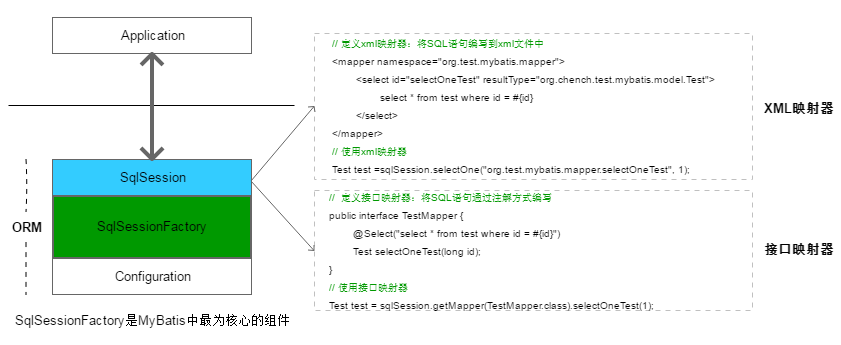
目录
概述
映射器是MyBatis中最核心的组件之一,在MyBatis 3之前,只支持xml映射器,即:所有的SQL语句都必须在xml文件中配置。而从MyBatis 3开始,还支持接口映射器,这种映射器方式允许以Java代码的方式注解定义SQL语句,非常简洁。

XML映射器
xml映射器是MyBatis原生支持的方式,功能非常强大。
定义xml映射器
xml映射器支持将SQL语句编写在xml格式的文件中。
<?xml version="1.0" encoding="UTF-8"?>
<!DOCTYPE mapper
PUBLIC "-//mybatis.org//DTD Mapper 3.0//EN"
"http://mybatis.org/dtd/mybatis-3-mapper.dtd">
<mapper namespace="org.chench.test.mybatis.mapper">
<select id="selectOneTest" resultType="org.chench.test.mybatis.model.Test">
select * from test where id = #{id}
</select>
</mapper>
配置xml映射器
对于MyBatis是独立使用还是与Spring框架集成这2种不同的场景,可以使用2种可选的方式注册xml映射器。
- 独立使用MyBatis
独立使用时注册xml映射器只能在MyBatis配置文件中(如:mybatis-config.xml)通过mapper节点实现。
<configuration>
<mappers>
<!-- 注册xml映射器: 2种方式 -->
<!-- 方式一: 使用相对于类路径的资源引用 -->
<mapper resource="org/chench/test/mybatis/mapper/xml/TestMapper.xml"/>
<!-- 方式二: 使用完全限定资源定位符(URL) -->
<!--<mapper url="file:///var/config/TestMapper.xml" />-->
</mappers>
</configuration>
- 在Spring框架中集成MyBatis
在Spring框架中集成MyBatis时,注册xml映射器有2种可选的方式:既可以在MyBatis配置文件中(如:mybatis-config.xml)配置,也可以直接在SqlSessionFactoryBean中通过属性mapperLocations进行注册。
(1)将xml映射器注册放在MyBatis配置文件中(如:mybatis-config.xml),但是此时必须在SqlSessionFactoryBean中通过属性configLocation指定MyBatis配置文件的位置。
<!-- 配置sqlSessionFactory -->
<bean id="sqlSessionFactory" class="org.mybatis.spring.SqlSessionFactoryBean">
<property name="dataSource" ref="dataSource"/>
<!-- 指定MyBatis配置文件(只支持类路径,典型的值为"WEB-INF/mybatis-configuration.xml") -->
<property name="configLocation" value="mybatis-config.xml"/>
</bean>
(2)在SqlSessionFactoryBean中通过属性mapperLocations进行注册xml映射器。
<!-- 配置sqlSessionFactory -->
<bean id="sqlSessionFactory" class="org.mybatis.spring.SqlSessionFactoryBean">
<property name="dataSource" ref="dataSource"/>
<!-- 注册xml映射器 -->
<property name="mapperLocations" value="classpath*:org/chench/test/mybatis/mapper/xml/**/*.xml"/>
</bean>
使用xml映射器
对于xml映射器的使用方式,如果使用SqlSession进行调用,独立使用或者在Spring框架中集成基本上是一致的。需要注意的是:当MyBatis在Spring框架中集成使用时,不需要直接从sqlSessionFactory中获取sqlSession对象,而是可以使用spring管理的sqlSession对象。另外当在Spring框架中集成MyBatis时,还可以直接通过接口使用xml映射器。
- 独立使用MyBatis
独立使用MyBatis时,对于xml映射器只能使用SqlSession进行调用。
// 从类路径下的xml配置中构建SqlSessionFactory
String resource = "mybatis-config.xml";
InputStream is = Resources.getResourceAsStream(resource);
SqlSessionFactory sqlSessionFactory = new SqlSessionFactoryBuilder().build(is);
// 从sqlSessionFactory中获取sqlSession
// SqlSession的作用域最好是请求或方法域,且在使用完毕之后及时释放资源,而且一定要确保资源得到释放
SqlSession sqlSession = sqlSessionFactory.openSession();
// 从xml映射配置中查询
Test test = sqlSession.selectOne("org.chench.test.mybatis.mapper.selectOneTest", 1);
sqlSession.close();
- 在Spring框架中集成MyBatis
(1)使用SqlSession调用xml映射器,方式与独立使用MyBatis时基本一致,只是获取SqlSession实例的方式不同。
// 启动spring容器
ApplicationContext context = new ClassPathXmlApplicationContext("mybatis-spring.xml");
// 使用xml映射器
// 不需要直接从sqlSessionFactory中获取sqlSession对象,而是可以使用spring管理的sqlSession对象
// SqlSessionFactory sqlSessionFactory = (SqlSessionFactory) context.getBean("sqlSessionFactory");
// SqlSession sqlSession = sqlSessionFactory.openSession();
// Test test = sqlSession.selectOne("org.chench.test.mybatis.mapper.selectOneTest", 1);
// 直接使用spring提供的sqlSession
SqlSession sqlSession = (SqlSession) context.getBean("sqlSession");
Test test = sqlSession.selectOne("org.chench.test.mybatis.mapper.selectOneTest", 1);
此时,需要在Spring框架中注入SqlSession实例。
<!-- 在Spring框架中注入SqlSession实例-->
<bean id="sqlSession" class="org.mybatis.spring.SqlSessionTemplate">
<constructor-arg index="0" ref="sqlSessionFactory"/>
</bean>
(2)使用接口调用xml映射器
当在Spring框架中集成MyBatis时,对于xml映射器的使用除了可以通过SqlSession实例进行调用,还可以直接通过接口进行调用。注意:此时在定义Java接口和注册xml映射器时需要遵循一定的约定。
首先,定义的Java接口必须在org.mybatis.spring.mapper.MapperScannerConfigurer的属性basePackage指定的包或者子包下,如下所示:
<bean class="org.mybatis.spring.mapper.MapperScannerConfigurer">
<property name="basePackage" value="org.chench.test.mybatis.mapper.impl"/>
</bean>
org.mybatis.spring.mapper.MapperScannerConfigurer由Spring框架注册,并设置basePackage属性值为org.chench.test.mybatis.mapper.impl,那么对应的Java接口就只能定义在Java包org.chench.test.mybatis.mapper.impl下,并通过Spring框架注册Bean,如下所示:
// Jav接口所在包位置
package org.chench.test.mybatis.mapper.impl;
// 接口通过Spring框架注册Bean
@Repository
public interface DemoMapper {
public Demo selectOne(long id);
}
其次,注册xml映射器时需要将namespace属性设置为上述Java接口的完整类名称,同时设置操作语句元素的id属性为接口内的指定方法名称。
<?xml version="1.0" encoding="UTF-8"?>
<!DOCTYPE mapper
PUBLIC "-//mybatis.org//DTD Mapper 3.0//EN"
"http://mybatis.org/dtd/mybatis-3-mapper.dtd">
<!-- 将xml映射器的namespace属性设置为完整的接口类名称 -->
<mapper namespace="org.chench.test.mybatis.mapper.impl.DemoMapper">
<!-- 将操作语句元素的id属性设置为接口方法名称 -->
<select id="selectOne" resultType="org.chench.test.mybatis.model.Demo">
SELECT * FROM demo WHERE id=#{id}
</select>
</mapper>
在遵守上述约定注册对应的xml映射器之后,就可以直接通过对应的Java接口调用xml映射器了。
// 启动spring容器
ApplicationContext context = new ClassPathXmlApplicationContext("mybatis-spring.xml");
// 使用接口调用xml映射器
DemoMapper demoMapper = context.getBean(DemoMapper.class);
Demo demo = demoMapper.selectOne(1);
- xml映射器使用方法的比较
xml映射器的使用方式根据MyBatis的使用场景而不同,总结如下:
(1)独立使用MyBatis时,只能通过SqlSession使用xml映射器,调用时必须指定xml映射器中的操作语句id,比较繁琐。
Test test = sqlSession.selectOne("org.chench.test.mybatis.mapper.selectOneTest", 1);
(2)在Spring框架中集成MyBatis时,使用xml映射器比较灵活。除了可以通过SqlSession使用,还可以通过Java接口直接调用。对于开发者来说,直接调用接口方法会更加简洁;同时还能使用xml映射器的灵活与强大功能,可谓一举多得。
接口映射器
接口映射器是从MyBatis 3才开始支持的,其实就是支持在Java接口方法上通过注解方式编写SQL语句,而不再需要xml文件格式的配置。但请注意:使用注解编写SQL语句这种方式在某些场景下存在一定的限制,特别是处理复杂SQL的时候。虽然其有一定的简洁性,但同时也带来了局限性。通常都是将xml映射器和接口映射器联合使用。
定义接口映射器
定义接口映射器就是通过注解在Java接口方法上编写SQL语句,如下所示:
// 定义接口映射器
public interface TestMapper {
// 通过MyBatis的注解在Java接口方法上编写SQL语句
@Select("select * from test where id = #{id}")
Test selectOneTest(long id);
}
配置接口映射器
对于MyBatis是独立使用还是与Spring框架集成这2种不同的场景,注册接口映射器的方式各不相同,必须注意这一点。
- 独立使用MyBatis
在独立使用MyBatis时,接口映射器只能在MyBatis的配置文件中(如:mybatis-config.xml)通过mapper节点指定,如:
<mappers>
<!-- 注册接口映射器: 2种方式 -->
<!-- 方式一: 明确注册每一个接口 -->
<!--
<mapper class="org.chench.test.mybatis.mapper.impl.TestMapper" />
<mapper class="org.chench.test.mybatis.mapper.impl.StudentMapper" />
-->
<!-- 方式二: 指定映射器接口所在Java包名称,则该包下的所有映射器接口都会被注册 -->
<package name="org.chench.test.mybatis.mapper.impl"/>
</mappers>
- 在Spring框架中集成MyBatis
在Spring框架中集成MyBatis时,接口映射器只能通过org.mybatis.spring.mapper.MapperScannerConfigurer注册,指定其basePackage属性值为需要注册映射器接口所在的包,可以在该包及其子包下定义接口映射器。
<bean class="org.mybatis.spring.mapper.MapperScannerConfigurer">
<!-- 定义接口映射器所在的Java包 -->
<property name="basePackage" value="org.chench.test.mybatis.mapper.impl"/>
</bean>
使用接口映射器
根据MyBatis的使用场景不同,使用接口映射器的方式也不同。
- 独立使用MyBatis
独立使用MyBatis时,只能通过SqlSession使用接口映射器,此时也需要开发者自己释放SqlSession资源。
// 从类路径下的xml配置中构建SqlSessionFactory
String resource = "mybatis-config.xml";
InputStream is = Resources.getResourceAsStream(resource);
SqlSessionFactory sqlSessionFactory = new SqlSessionFactoryBuilder().build(is);
// 从sqlSessionFactory中获取sqlSession
// SqlSession的作用域最好是请求或方法域,且在使用完毕之后及时释放资源,而且一定要确保资源得到释放
SqlSession sqlSession = sqlSessionFactory.openSession();
// 从映射器接口中查询
Test test = sqlSession.getMapper(TestMapper.class).selectOneTest(1);
sqlSession.close();
- 在Spring框架中集成MyBatis
在Spring框架中集成MyBatis时,接口映射器的Bean由Spring框架来管理,此时只需要直接获取对应的接口映射器Bean并调用方法即可。
// 启动spring容器
ApplicationContext context = new ClassPathXmlApplicationContext("mybatis-spring.xml");
// 从Spring容器中获取接口映射器Bean
TestMapper testMapper = context.getBean(TestMapper.class);
Test test = testMapper.selectOneTest(1);
总结与对比

- 从MyBatis 3开始,同时支持2种类型的映射器:xml映射器和接口映射器。
- xml映射器是MyBatis原生支持的映射器方式,优点是功能强大,缺点是配置显得臃肿和复杂;接口映射器支持通过注解的方式在Java接口方法上编写SQL语句,优点是简洁,不再依赖外部xml配置,缺点是功能没有xml映射器强大。需要特别注意的是,在接口映射器中使用
@SelectProvider注解动态拼装SQL时存在SQL注入攻击的风险。因此,通常都是将二者联合使用,即可以使用接口映射器带来的简洁性,也能使用xml映射器的强大功能。 - 2种映射器都可以分为独立使用和在Spring框架中集成使用2种不同的方式,独立使用时需要开发者自己处理事务管理和资源释放;在Spring框架中集成时事务管理和资源释放交给Spring框架处理,对开发者是透明的,更加高效和友好。
- 对于批量添加记录需要返回主键字段值的需求,只能在xml映射器中实现,接口映射器无能为力。